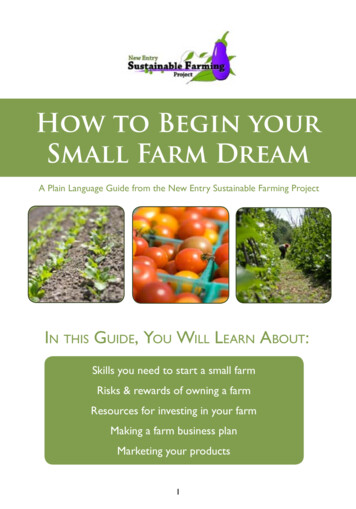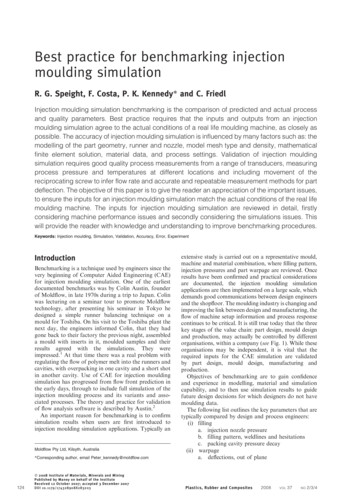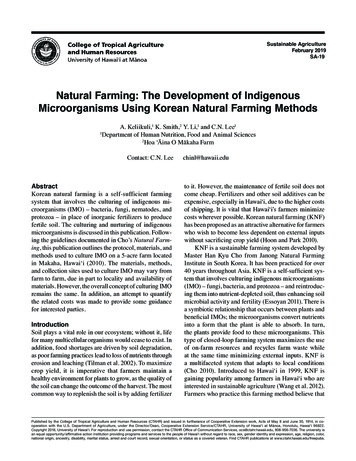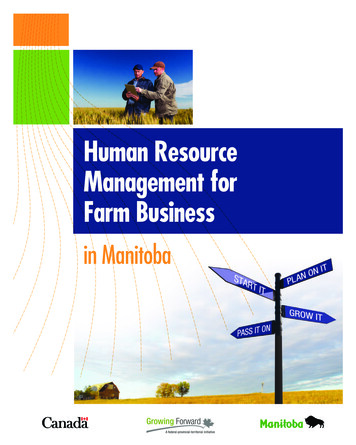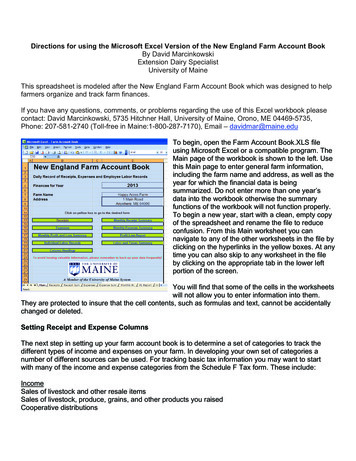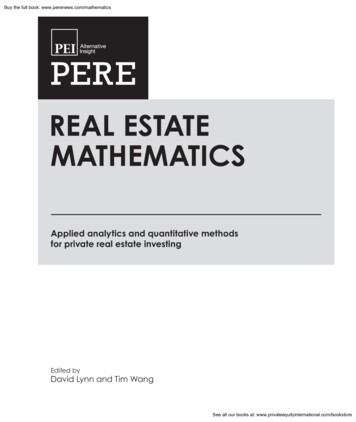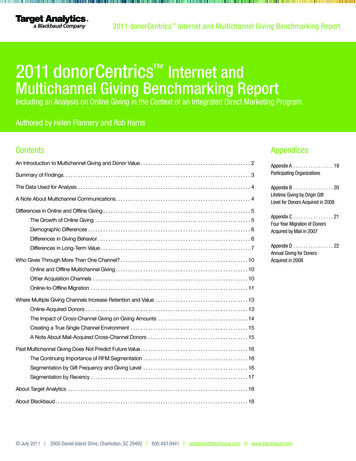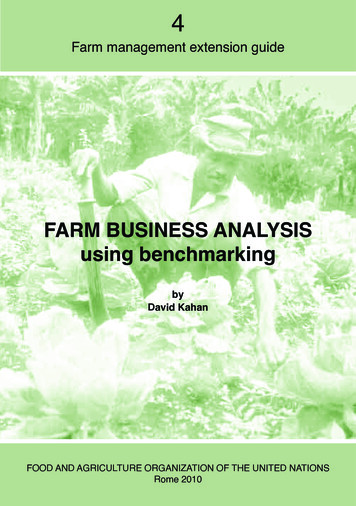
Transcription
4Farm management extension guideFARM BUSINESS ANALYSISusing benchmarkingbyDavid KahanFOOD AND AGRICULTURE ORGANIZATION OF THE UNITED NATIONSRome 2010
The designations employed and the presentation of material in this informationproduct do not imply the expression of any opinion whatsoever on the part of theFood and Agriculture Organization of the United Nations (FAO) concerning thelegal or development status of any country, territory, city or area or of its authorities,or concerning the delimitation of its frontiers or boundaries. The mention ofspecific companies or products of manufacturers, whether or not these have beenpatented, does not imply that these have been endorsed or recommended by FAO inpreference to others of a similar nature that are not mentioned.The views expressed in this information product are those of the author(s) and donot necessarily reflect the views or policies of FAO.ISBN 978-92-5-107545-6 (print)E-ISBN 978-92-5-107546-3 (PDF) FAO 2013FAO encourages the use, reproduction and dissemination of material in thisinformation product. Except where otherwise indicated, material may be copied,downloaded and printed for private study, research and teaching purposes,or for use in non-commercial products or services, provided that appropriateacknowledgement of FAO as the source and copyright holder is given and thatFAO’s endorsement of users’ views, products or services is not implied in any way.All requests for translation and adaptation rights, and for resale and othercommercial use rights should be made via www.fao.org/contact-us/licence-requestor addressed to copyright@fao.org.FAO information products are available on the FAO website (www.fao.org/publications) and can be purchased through publications-sales@fao.org.
iiiPrefaceFarming for profit calls for a different approach to farming.Farmers are not only concerned with the day to day tasksinvolved in making a living but they increasingly planfor the future in an effort to make money. For businessminded farmers profit is viewed as the goal; the goal thatensures survival of the business. The performance ofthe farm can best be explained by better understandingthe farm business, identifying the goals set by the farmerand examining the factors that affect them.Performance is concerned not only with the ‘bottom line’of making money but also technical aspects of farmingthat contribute to making the farm business profitable andefficient. Improving the performance of the farm businessrequires a good understanding of both the business andtechnical aspects of farming. ‘Benchmarking’ is a conceptthat is used to analyse and better understand the farmas a business. To do this benchmarking is conducted ina way similar to a doctor diagnosing the condition of apatient. Diagnosing performance means understandingbusiness concepts such as profitability and efficiency,identifying the problems that prevent the farm fromachieving its potential and formulating strategies andactions to improve its business performance.How do you, as an extension worker, assistfarmers in finding ways of making improvements tothe farm business? How do you as an extensionworker help farmers improve profitability andperformance?
ivAcknowledgementsThe author would like to acknowledge the assistance ofcolleagues and friends. Thanks are due to Doyle Bakerand Steve Worth for their review of the guide, MartinHilmi for his contributions and reviews, Tom Laughlin,who managed the post-production process and MichaelBreece, for the design and final layout of the publication.David KahanSenior Officer,Agricultural Innovationand Extension
vContentsPreface. iiiAcknowledgements. ivAttention extension workers. viPart 1INTRODUCTION TO BENCHMARKINGChapter 1: Benchmarking in farm business analysis. 3Chapter 2: Steps involved in benchmarking . 19Chapter 3: Benchmarking in extension. 27Part 2STEP-BY-STEP FIELD GUIDEOrganizationStep 1: Organize benchmark learning groups. 42IdentificationStep 2: Identify problems to be examined. 48Step 3: Identify performance indicators. 52Step 4: Identify benchmark farms. 72Data collectionStep 5: Collect comparable data and information. 77ComparisonStep 6: Compare performance. 93AnalysisStep 7: Interpret differences. 99SharingStep 8: Share findings and results . 113Plan for changeStep 9: Devise plans and implement changes. 119Monitor and evaluateStep 10: Reflect and evaluate results . . 125Annex: Business concepts for benchmarking. 129Glossary. 137Bibliography. 141
viAttention extension workersThe methods recommended in this guide requirefamiliarity with basic farm management economicsas covered in Farm Management Extension Guide2. The guide is expected to be used by extensionworkers with university level training and at leastan introductory training in farm managementeconomics. In countries where extension workersdo not have this background, the more likely userof the guide would be farm management specialists.The role of farm management specialists is broadand their responsibilities are covered in FarmManagement Extension Guide 4.While benchmarking is useful for all types of smallscale farmers, family farmers that produce mainly forhousehold consumption as well as market-orientedfarmers, its practical use in farm business analysiswill be more appreciated among commercially mindedfarmers that wish to improve their profitability andcompetitiveness.While the guide draws on known farm managementmethods and experiences, the recommendationson approaches and activities for benchmarking arenew and mostly untested. This guide is thereforebeing made available to stimulate innovation andadaptation.Benchmarking may at first seem somewhat complex,but when the procedure is carefully explained andgiven an operational structure to follow, the processbecomes much easier. This guide sets out to do justthat. How the guide has been structured and what thereader can expect to find is briefly described below.
viiPart 1: Introduction to benchmarking and overview.This part begins with a discussion on benchmarking andhow it is applied (informally, formally, internally, externally)followed by an introduction to the key concepts needed toanalyse and measure farm and enterprise performance(profit, profitability, efficiency). A brief overview of a tenstep process to conduct a benchmarking exercise is alsogiven. This part ends with a section on benchmarkingand its application in extension work.Part 2: Step-by-step field guide. This part has beenstructured to provide detailed guidance for extensionworkers on how to undertake a benchmarking exercise:A ten-step process is described. Readers are urgedto study the sequence from beginning to end until theprocess is clearly understood. Benchmarking proceduresand data collection are discussed including some things‘to do’ and some things ‘not to do’ in the field.Each of the ten steps includes ‘Tips’ and ‘Questions toinitiate discussion’ when conducting an exercise. This isto help and support you in the practical application ofbenchmarking.Undoubtedly, during the course of reading, you willdevelop ideas of your own on how you plan to conductyour field exercises. These should be listed. Space hasbeen provided for notes and observations. The materialthat has been covered here, together with your list ofideas, is intended to be used as a field guide. Remember,the best way to learn how to benchmark is by practice.
Part 1Introduction to benchmarking
Chapter 1Benchmarking in farm business analysis
4Farm business analysis using benchmarkingCHAPTER 1Benchmarking: an overviewOVERVIEW OF THE MAIN CONCEPTSBenchmarkingcan lead toincreasedprofit . andprofitability . andto improvedefficiencyin thefarm businessBenchmarkingThe process used to identify, learn fromand adapt better practices from other farmersto help improve farm performance.ProfitThe difference between money that comes infrom the sales of a productand the money that goes out to produce it.Profit is used to measure the successof the farm business and is vitalfor its survival and growth.ProfitabilityA measure of performance that shows howwell the resources available to the farmerare used to generate income and profit.EfficiencyEfficiency is the careful useof the resources available to the farmer.Efficiency can be either technical(producing the highest possible outputfrom a given set of inputs)or economic (the financial returnsfrom resources used).
5Benchmarking in farm business analysisBENCHMARKINGWhat is benchmarking?The term ‘benchmarking’ is used to cover a number ofpractices found in farming that are designed to highlightthe good and make it possible to avoid the harmful.Benchmarking ,in business practice, is used to signifya particular systematic approach in which a businessevaluates its own operations and procedures througha detailed comparison with those of another business,in order to establish best practices and improveperformance.When using benchmarking in farming, it involvesgathering data about the best performing farms andcomparing them with other farms. Benchmarking canshow how higher levels of performance can be achieved.Many insights can be gained through a benchmarkingexercise. It can uncover problems of production,management practices and other factors that affectproductivity, cost of production and profitability. Theseinsights and discoveries can be used to improve farmperformance.Benchmarking is a process of identifying,learning from and adapting good practicesand processes to help improve performance. but remember, benchmarking requirescomparing like with like.The process starts by identifying farms and farmersthat are performing well and are successful at whatthey do. It requires a thorough understanding of theirfarming practices in order to identify strengths andweaknesses and steps needed to improve performance.The performance of these ‘benchmark’ farms are set asa standard for farmers to compare themselves against.There are twomain parts inbenchmarking . collecting datafrom farms andcomparing this dataagainst abenchmark farm . to makemeaningfulcomparisons,it is necessaryto collectsimilar data
6Farm business analysis using benchmarkingInformalbenchmarkingcan help improveperformance . however, to beefficient farmersneed to approachthe process in amore structured,formal mannerInformal benchmarkingFarmers often do benchmarking informally. A farmersees another farmer with a larger harvest or one whogets a better price for the same product at the samemarket. Why is this so? A farmer hears of another farmerwho reduces costs by introducing a new technology.Should she or he do the same? By observing and talkingto successful farmers, others can learn how to improvethe performance of their farms. Informal benchmarkingcan result from something as straightforward as a walkaround someone else’s farm. Farm visits are consideredan important part of benchmarking and will be discussedlater.Formal benchmarkingHowever, for best results farmers will need to learn how tobenchmark through a more systematic approach. Formalbenchmarking takes farmers through the following steps: examine their own farms and look for areas forimprovement; identify a similar farm that is performing better; study that farm in detail and try to find out what it isthat the farmer does better; compare the performance of the two farms andunderstand the reasons for differences; plan and introduce changes to their farms based onwhat they have learned.Formal benchmarking providescomparison. It can be applied to:astandardfor compare the performance of any farm with a moresuccessful farm; compare the past performance of a farm; compare a farm plan with the actual outcome; compare production levels to check if the farm istechnically efficient; compare production costs to check if the farm iseconomically efficient; examine the production and marketing processes todetermine if they are sound;
Benchmarking in farm business analysis learn from the experience of other farmers andgenerate new ideas.Benchmarking can be internal to the farm businessor external by comparing one farm with anotherInternal benchmarkingInternal benchmarking takes place when the performanceof the farm business is compared with itself. This is aninternal assessment of past results to determine waysto improve. Over time the farm business is analysed,performance is measured, weaknesses and opportunitiesare identified, and on this basis improvements can bemade. Good farm records are of great help with this.Results of internal benchmarking can often be quite quick.The challenge is to know what farmers can do to improveperformance once these lessons have been learned.The solution for farmers, however, often lies beyond thefarm boundaries. This leads to external benchmarking.External benchmarkingExternal benchmarking involves comparing theperformance of a farm business with the performanceof other farms that have similar farm enterprises. Thebenchmark may be a competing farmer or simply asuccessful one who is ready to share his or her goodfarm management practices with other farmers in thevicinity. Either way, the benchmark farm serves asa demonstration of how things should be done. It canbe studied, learned from and copied. (Depending onthe farm enterprises and operations that are beingexamined, there could even be a number of benchmarkfarms selected for comparison.)When should benchmarking be conducted?Benchmarking can be conducted at all times andat all stages of the farm decision-making cycle,from diagnosis and planning to implementation.7
8Farm business analysis using benchmarkingComparative analysisIn developed countries, benchmarking hastaken the form of detailed studies of theperformance of farms located in the same area.Farms are usually clustered around similarityof the farming system and technology base.Benchmarks are identified by averaging datacollected on farm performance from surveysof large groups of farms. The data collectedis usually averaged out and standardiseddata is used for comparison. Sets of data areoften calculated for different sub-groups offarms. Benchmarks on farm and enterpriseprofitability are commonly calculated. Highprofit benchmarks can be derived by selectingthe farms in a group that are most profitable.Similarly other farms can be categorised as“weak” and average” performing.There are many developing countries thathave also institutionalised the traditionof collecting farm management data forcomparative analysis. Annual or six-monthlyreports are often prepared on a regularbasis. The performance measures derivedfrom the data are used at local levels infarm advisory work and at national levelsto inform agricultural policy. This form ofbenchmarking is complex and requires theuse of spreadsheets to analyse detailedfinancial and physical data. Within the farmmanagement discipline this has traditionallybeen called comparative analysis.
Benchmarking in farm business analysisUsing ‘benchmarking’ as a toolfor improved farm production and incomeA small-scale farmer has a two hectare farm. She grows beans,cassava and millet. Half of her crop is sold at market and the rest isused by her family. She would like to do better and increase her yieldsand income. It seems that there are a few farmers in her area whodo very well. They grow similar crops, produce more food and havehigher incomes. She wants to understand how they do it. She contactsthe local extension worker for advice.The local extension worker suggests that together they visit a ‘better’performing farm to gather information on methods of production,management and marketing practices. With this information they canidentify ‘good practices’ as benchmarks for comparison. Using theseas a guide she discovers new production practices and begins toexperiment with small-scale drip irrigation, the better use of fertilizerand better harvesting practices.She also knows that she should be making more money at themarket. She learned from the ‘successful’ farmer that keeping an eyeon the market and understanding market price information better isimportant. She collects market price data and finds that her main cropis harvested when prices are usually low. She knows from this exercisethat the successful farmer either planted early or late in the season inorder to avert low prices at harvest time. She learns to take more careabout when to plant her crops.After following these practicesour farmer finds herself with anincrease in production and surplusesto sell in the market at better prices.This she understands will improvethe livelihood of her family.9
Farm business analysis using benchmarking FAO/J Van Acker/820510Women in Sierra Leone discussing farm enterprise alternatives FAO/J Spaull/21640‘Benchmarking’can be used atall stages in theproduction cycle . from planning,to planting andmarketing FAO/J Thompson/24306A farmer in South Africa diversifying her enterprises by introducing tomatoesImproved handling and marketing of horticultural produce in Thailand
Benchmarking in farm business analysis FAO/15110/L Callerholm11 FAO/17816/A ContiLearning group discussing suitable formats for record-keeping – Sierra Leone FAO/21489/G BizzarriFilling out a data sheet on market prices for record-keeping – ZambiaFarmers discussing and comparing benchmarking data – El SalvadorIt’s a good thingto keep detailedrecords of farmactivities . it will makebenchmarkingmuch easier!
12Farm business analysis using benchmarkingFARM BUSINESS ANALYSISTo use benchmarking effectively, extension workers needto understand and apply the concepts of profitability,technical efficiency and economic efficiency as they relateto the farm business. Further, the relationships betweeninputs, costs, outputs and income also need to be clearlyunderstood. The key concepts of profit and efficiency areexplained below. For more detailed understanding thereader should refer to the Annex on Business Conceptsfor Benchmarking.Profit is necessaryto ensure thesurvival andgrowth of thefarm businessProfitProfit is the difference between the money that comes into the farm business from the sales of a product and themoney that goes out to produce it. The money coming inis expressed as the total value of production. The moneyspent is expressed as costs.Profit shows whether it is worthwhile engaging orremaining in the business. A number of reasons follow.Profit is necessary to keep the farm business going.If inadequate profits are generated the farmer will haveto sell equipment, farm implements and other assetsin order to find the money to cover everyday costs. Ifthe situation carries on for too long the farmer may endup selling the farm. The farmer would then be out ofbusiness.Profit is necessary for growth of the farm business.A farm business needs money in order to developand grow. Profit generates this money. The moneyaccumulated from profits can be used to buy newmachinery, equipment and implements. It can also beused to rent or buy additional land. In this way, the farmbusiness can grow and expand.
Benchmarking in farm business analysis13Profit is used to measure the success of the farm asa business. Profit can be used as an indicator showingthe success of the business. The more profit the farmermakes the more successful the business is and the morelikely it is to survive.Profit is a reward. Farmers and their families put in theirtime and effort to work on the farm to earn ‘benefits’. Inmost cases, the family members are not paid a salarylike other workers. Profit represents their ‘wages’. It canalso be understood as a reward for their energy, time andeffort in managing and working the farm. Profit can beseen as a return for the time and capital invested.Profit is a wage,profit is a rewardfor effort, andprofit is a returnon investmentProfit provides money for the farm family. Profitprovides the money farmers and their families need to buyadditional goods and services and to pay for educationand health care. The greater the profit, the more farmerscan provide for their families.Profit is a wage, profit is a reward for effort, and profit isa return on investment.ProfitabilityProfitability measures how well the farm business usesthe resources available to generate income and profit.Profit and profitability are not the same. As mentionedbefore profit is the amount of money earned after totalcosts are deducted.Two farmers may show the same profits but may notbe equally profitable. This could be a result of the wayfarmers use their resources. In order to compare thesefarms, we need to see exactly how the farmers make useof their resources to generate profits. As an example, ifa farmer makes a profit of 1 000 we do not know if thislevel is high or low. Could the farmer have earned moreby using the resources differently?Using profitability as a basis for comparison instead ofprofit means that one can compare like with like. A farm of2 hectares can be compared with a farm of 20 hectares.Profitability isa measure thatattempts to answerthe question“Are we makingenough money forthe effort?”
14 FAO/20887Farm business analysis using benchmarkingThese farmers in Senegal used their profits to invest in a new cucumber enterprise FAO/22882/G DianaProfitsare veryimportantfor thefarm family FAO/13210/F Mc DougallProfits can mean farm families in Bangladesh have more and different foods to eatProfits mean that farmers in Sudan can send their children to school
Benchmarking in farm business analysis15It may well be that while the farm of 2 hectares makesless profit than the farm with 20 hectares; the small-scalefarm may be more profitable.To compare profitability and performance, a farmer canuse common measures such a gross margin, enterpriseprofit and farm profit *.EfficiencyEfficiency is the careful use of the resources availableto the farmer. While the farm business may generateprofits and be profitable, an important question to ask iswhether or not the farm business is efficient. A farm thatis efficiently run is more likely to be profitable than a farmthat is not. There are two forms of efficiency .technicaland economicTechnical efficiency: There is usually more than oneway to grow a crop or raise livestock. It is possible toproduce farm products by farming a small quantity of landvery intensively, combining a lot of labour and capital. Itis also possible to produce the same product by farmingthe same land area extensively, with only small amountsof labour and capital. Technical efficiency is producingfarm products with the best combination of resources orinputs. Technical efficiency measures the farmer’s skilland success in producing the highest possible level ofoutput from a fixed amount of inputs. It can be calculatedby estimating crop and livestock yields, and the use ofinputs such as fertilizer and labour. Technical efficiencyis measured as yield per unit of a specific input as, forexample, kilograms of fertilizer or seed.Economic efficiency: Economic efficiency measuresthe financial returns on resources used. Economicefficiency looks at the cost of using resources to producea given level of output. The most economically efficientmethod of production is the one that costs the least.It should be mentioned that methods that are technicallyefficient may not be economically efficient.Technicalefficiencyoccurs when themaximum amountis provided givena set of inputs
Farm business analysis using benchmarking FAO/14519/D Debert16Is this method of fertilizing a crop in Burkina Faso technically efficient? FAO/11852/C ErrathTechnicalefficiencyis producingfarm productswith the bestcombinationof resourcesor inputs FAO/22285/A ProtoOr is this method more technically efficient in the use of fertilizer?Is this method of watering small vegetables in Mozambique technically efficient?
17 FAO/23030/K IversenBenchmarking in farm business analysisIs this small plot of intercropping in Ecuador economically efficient? FAO/18309/P CeniniEconomicefficiencymeasures thefinancialreturns onresources used FAO/22842/G DianaOr is this larger plot of intercropping in Ghana more economically efficient?Is using a motor tiller economically efficient for planting rice?
18Farm business analysis using benchmarkingTo use benchmarking effectively,farmers need to understandand apply the concepts of profitability,technical efficiency and economic efficiencyas they relate to the farm business.Further, the relationships betweeninputs, costs, outputs and incomealso need to be clearly understood.
Chapter 2Steps involved in benchmarking
20Farm business analysis using benchmarkingTHE BENCHMARKING PROCESSAn overview of the benchmarking process is outlinedin Figure 1. Figure 2 presents the ten step process inmore detail. In most cases this exercise is conductedby extension workers and farmers together. Theobjective is to compare the profitability of the farmsselected for study in order to improve their farmbusiness performance and profitability. The informationgained can be shared with other farmers which, in itself,can add to the learning process. It may also lead to newbusiness opportunities. The benchmarking processcan be continuous, with farmers constantly checkingtheir performance against that of others and workingto improve their profitability. It should be noted that thesteps in the benchmarking process can overlap.Figure 1The four workingcategories in NITOR AND EVALUATEPLAN FOR CHANGESHARINGDATA COLLECTIONCOMPARISONANALYSIS
21ORGANIZATIONStep 1Organize benchmark learning groupsIDENTIFICATIONStep 2Identify problems to be examinedStep 3Identify performance indicatorsStep 4Identify benchmark farmsDATA COLLECTIONStep 5Collect comparable data and informationCOMPARISONStep 6Compare performanceANALYSISStep 7Interpret differencesSHARINGStep 8Share findings and resultsPLAN FOR CHANGEStep 9Devise plans and implement changesMONITOR AND EVALUATEStep 10Reflect and evaluate resultsFigure 2The ten basicsteps in thebenchmarkingprocess
22Farm business analysis using benchmarkingO R G A N I Z AT I O NStep 1Organize benchmarklearning groupsIn preparing for the benchmarking process, farmersshould form learning groups where issues of farmmanagement and farm productivity can be discussed.Farmers do not usually come together by themselvesand often need someone to facilitate this process. So, asan extension worker, you may be required to assist in theformation of learning groups.I D E N T I F I C AT I O NStep 2Identify problems to be examinedProblems can be identified and examined by holdingdiscussions in the learning group and arriving at aconsensus. You may need to engage in a discussionabout aspects of their farms that they are satisfiedwith and aspects that they are dissatisfied with. Suchdiscussions provide a good foundation for the selectionof indicators and benchmark farms.
23Steps involved in benchmarkingI D E N T I F I C AT I O NStep 3Identify performance indicatorsThis involves identifying measures that best illustrate anddescribe farm performance. Performance measures canbe described in both physical and financial terms. Theycan be applied to the whole farm business as well as toindividual farm enterprises. Farmers in the learning groupneed to know their own farms well. A good understandingof the farming system in which the farmers operate willgreatly increase the success of any plan made at the endof the benchmarking process to improve the performanceof their own farms.I D E N T I F I C AT I O NStep 4Identify benchmark farmsIt is important to identify farmers in the learning groupor in the area who are performing well and can beregarded as benchmarks. With technical guidance fromyou the extension worker, farmers should agree on thefarm or farms to be used. It is also important that thoseconsidered are representative of a known farm type, sothat those conclusions drawn would have the widestpossible application.
24Farm business analysis using benchmarkingD ATA C O L L E C T I O NStep 5Collect comparable dataand informationThis requires the collection of data from both the learninggroup and the benchmarking farms. Information anddata from all sources should be consistent since this willform the basis for the comparisons to be made of thefarm businesses in question. Some other factors to beconsidered are: (i) the quality of the data, (ii) the cost andtime involved in collecting it, and (iii) ways in which thedata can be shared with other farmers.C O M PA R I S O NStep 6Compare performanceComparisons of the performance of the farm businesswith the benchmark farm are made at this step in theprocess. Financial and technical indicators are used tocompare performance and identify differences (gaps).These differences can suggest weaknesses within thefarming system and its parts and the reasons for them.Alternatively the differences may suggest strengths inthe farming system and its parts as well as the underlyingreasons for them. This in turn, could suggest opportunitiesfor improvement. The performance comparisons resultsin a better understanding of the causes of a problem andthese in turn can
Benchmarking in farm business analysis 7 learn from the experience of other farmers and generate new ideas. Benchmarking can be internal to the farm business or external by comparing one farm with another Internal benchmarking Internal benchmarking takes place when the performance of the farm

